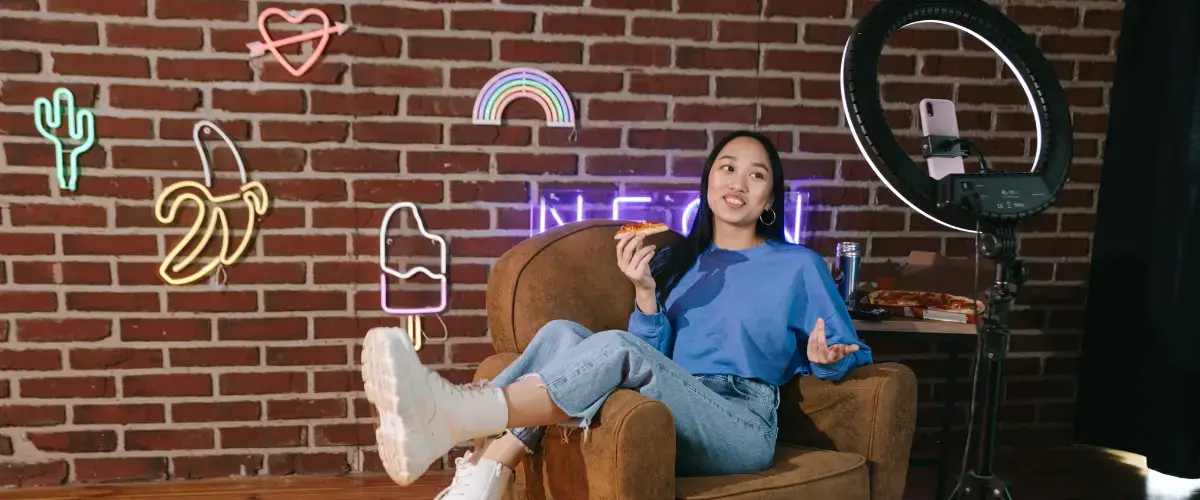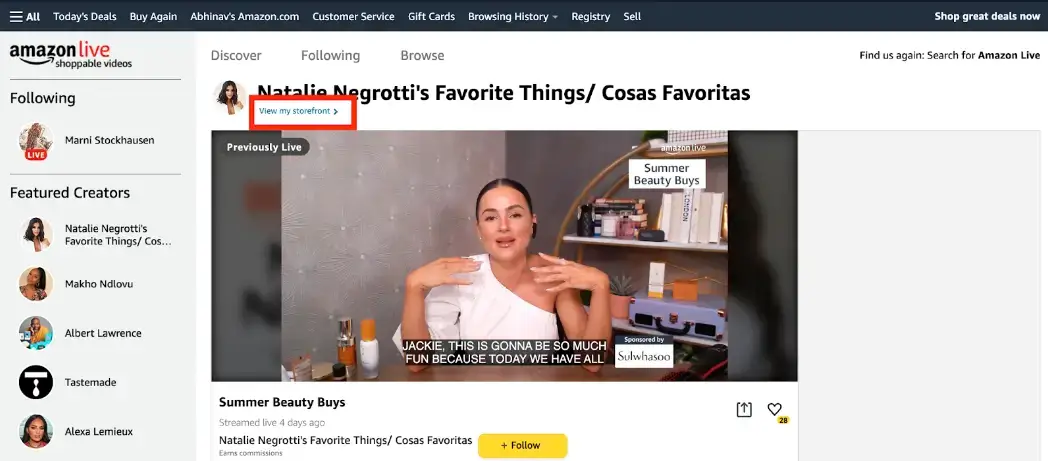What would you like better? Reading about a new product in the market or seeing it in action? 96% of customers prefer seeing a product video to understand how it works.
That’s why videos play a huge role in digital marketing strategies - especially influencer marketing. Viewers love to see their favorite influencers use and review a product on camera.
They can see live reactions and experiences. It also helps them make better purchase decisions. Let’s understand how videos amplify the effect of influencer marketing and help brands make a lasting impression.
Skip to:
- The Synergy Between Video & Influencer Marketing
- Types of Video Content in Influencer Marketing
- Benefits of Using Video in Influencer Marketing
- Tips for Effective Video Influencer Marketing

Custom image created in Canva
The Synergy Between Video and Influencer Marketing
Video and influencer marketing go hand-in-hand. Influencer marketing thrives on the fact that influencers can share their authentic experiences with the viewers.
For authenticity, influencers can share behind the scenes of their brand collaborations. They can provide a sneak peek into your company's operations. And what better way to do this than shooting videos?
Considering the shift towards more interactive and engaging content, converting text to video can serve as an alternative solution to elevate your message.
Video is more visually engaging than text or static images. It combines moving visuals, audio, and often text to deliver a multi-sensory experience. Your content becomes less salesy and more entertaining.
-
Enhancing video quality with desktop screen recording
An essential tool in the influencer toolkit for producing high-quality video content is a reliable desktop screen recorder. This technology allows influencers to capture their computer screens in high definition, making it ideal for creating tutorials, digital product reviews, or walkthroughs.
With a desktop screen recorder, influencers can easily share high-quality, informative content, adding a layer of professionalism to their videos that viewers appreciate.
Moreover, video review and feedback software enhances shareability on various social media platforms, enabling your brand's message to reach a wider audience.
Combine that with an influencer with millions of followers, and you have the recipe for content virality. It exponentially increases your brand's exposure.
Moreover, influencers can leverage video for better engagement. By sharing their honest opinions and experiences, they can attract more likes, comments, and shares.
Types of Video Content in Influencer Marketing
There are several types of videos that you can use to promote your product: Long-form, short-form, cinematic, B-rolls, and whatnot.
Let’s understand different video formats and how they impact your influencer marketing campaigns:
1. Channel-specific videos
The video format heavily depends on the platform. For example, YouTube is famous for long-form videos, while TikTok hosts 30-to 60-second videos. That’s why you must understand what works on each channel to get the most ROI from your influencer marketing campaigns.
YouTube: With its vast user base and diverse content, YouTube is a powerhouse for influencer marketing—for example, the makeup brand Sephora's collaboration with beauty influencer James Charles.
If you're managing multiple campaigns or want to save your favorite influencer content, using a YouTube playlist downloader can help you organize and access videos easily.
Charles's "Full Face Using Only Sephora Collection" video garnered millions of views and effectively showcased the brand's products to a highly engaged audience.

Instagram: On Instagram, you can promote through different types of videos. Reels, Stories, IGTV, and live are havens for video content. You can combine how-to videos, behind-the-scenes, and review videos for your Instagram marketing strategy.
H&M is one of the most popular brands that collaborates with influencers to launch new season picks. See how H&M shares reels by the famous influencer, ‘Kaliuchis’ to launch their 2023 summer collection.
TikTok: Known for its short-form, creative content, TikTok provides a unique opportunity for brands to go viral. The platform is famous because anybody can go viral on it. You only need simple and honest review videos to go viral on TikTok.
Ocean Spray is a standout example of TikTok virality. It experienced a surge in popularity when user @420doggface208 created a simple yet captivating video skateboarding while sipping Ocean Spray cranberry juice.
The video garnered millions of views and spawned countless imitations, offering a lesson in the potential of TikTok virality.
2. Live streaming
Live streaming has emerged as a game-changer in influencer marketing. It became a $500 billion market in 2022. The credit goes to the real-time interaction with audiences, which adds an authentic and unscripted dimension to campaigns.
To ensure such smooth interactions with your audience, consider using an srt server and ensure low latency and reliable streaming. Let's examine its significance through a compelling case: Case Example: Amazon's "Live" Shopping Streams.

Source: Amazon
Amazon Live, an initiative that allows influencers to showcase and discuss products while viewers shop, exemplifies the power of live streaming in influencer marketing.
Influencers engage directly with the audience, answer questions, and provide a personalized shopping experience, creating a live streaming platform. These live streams have boosted product sales and fostered a sense of community and trust among viewers.
3. User-generated videos
User-generated content (UGC) is the most valuable asset for influencer marketing, as it leverages the creativity and loyalty of the brand's customers. Viewers love user-generated videos.
They’re not only enjoyable, but they produce tangible results for brands. 79% of social media viewers say UGC significantly affects their purchasing decisions.
A great example of a brand that leverages UGC is GoPro, the action camera brand. It thrives on UGC. GoPro encourages its customers to share their adventure videos with the brand on social media.

Source: GoPro Instagram
GoPro also partners with influencers to curate and share these UGC videos on its social media platforms. This approach promotes the product's capabilities and fosters a sense of community among GoPro enthusiasts. GoPro now has 20.5M followers on Instagram and 10.7M subscribers on YouTube.
Benefits of Using Video in Influencer Marketing
Video combines visuals, audio, and often text, providing a multi-sensory experience. It allows character development, conflict, and resolution. Here’s how the use of videos amplify the effect of influencer marketing:
1. Improved storytelling and brand narrative
Videos are more compelling and emotionally resonant. It allows brands to tell stories that connect with their target audience. Influencers can craft engaging stories around your brand, creating a memorable and relatable experience for viewers.
Videos enable brands to showcase their products or services in action, highlighting features and benefits through real-world scenarios. This approach helps viewers understand how the brand fits into their lives.
2. Enhanced authenticity and trust
Authenticity is crucial in influencer marketing, and video can significantly enhance it. Here's how video content boosts authenticity and trust:
- Face-to-Face Interaction: Video allows influencers to speak directly to their audience. Viewers see the influencer's facial expressions and hear their voices, creating a sense of genuine interaction that fosters trust.
- Transparent Demonstrations: Influencers can use video to demonstrate or review your products or services publicly. This transparency builds confidence in the brand.
- User-Generated Content: User-generated video content, such as reviews and testimonials, is seen as highly authentic and trustworthy. When influencers share their own experiences with your product, it builds trust in your brand.
- Real-Life Context: Video allows influencers to showcase their brand within real-life contexts. So, promotion feels less like an advertisement and more like a genuine recommendation.
3. Increased reach and engagement
Video content performs exceptionally well on social media platforms. For example, viewers watch 1 billion hours of YouTube videos daily. Engaging and shareable videos can quickly go viral.
When influencers create compelling video content, their followers are more likely to share it with their networks and buy products directly from the links in the video content.
It results in a 29% higher marketing conversion rate than the campaigns that don’t use it.
Video can also incorporate interactive elements like polls, quizzes, and clickable links, encouraging viewers to engage directly with your brand. It attracts more comments and discussions than text-based content.
Tips for Effective Video Influencer Marketing
Although influencers are responsible for creating videos for your brand, you must conduct some backend research.
Even if you’re hiring social media video production companies to shoot your video campaigns, you must provide certain information in brief. Keep the following things in mind while using videos for your influencer marketing campaigns:
- Define clear objectives
Start by setting clear and measurable goals for your video influencer marketing campaign. Are you looking to increase brand awareness, drive sales, or boost engagement? Knowing your objectives will guide your strategy.
|
Brand awareness |
|
|
Community building |
|
|
Lead generation |
|
|
Sales conversions |
|
|
User-generated content |
|
- Choose the right influencers
Choosing the right influencer is super crucial for any campaign. If the influencer doesn’t do it right, the partner brand can face backlash.
Take James Charles and Morphe's collaboration, for example. James Charles is one of the biggest beauty influencers around the globe. He collaborated with Morphe to launch their new palette.

But later, it was found that James had sent sexual messages to minor boys. Since Morphe was associated with James for their latest campaign, the brand faced severe backlash from the community.
Due to the backlash, they had to terminate the collaboration, wasting funds, creative efforts, and time.
Select influencers whose values and content align with your brand and target audience to avoid such mistakes. Also consider micro-influencers as well.
Micro-influencers are often easier to reach, cost much less, and have a deeper connection and following.
Look for authenticity and a genuine connection with their followers. Track their past campaigns to verify the success or failures of their brand collaborations.
- Mobile optimization
90% of viewers watch videos on mobile. That’s why it’s crucial to optimize your videos for mobile.
For example, large graphics and landscape frames never work on mobile. Here’s how you optimize your videos for mobiles:
|
Choose the Right Format: |
Use mobile-friendly video formats like MP4 with H.264 codec, which are widely supported on mobile devices. |
|
Resolution and Aspect Ratio: |
Opt for a resolution suitable for mobile screens (e.g., 720p or 1080p). Ensure the aspect ratio fits mobile screens (commonly 16:9 for landscape and 9:16 for portrait). |
|
Compression: |
Compress videos to reduce file size without compromising quality. Tools like HandBrake or Adobe Media Encoder can help. |
|
Bitrate: |
Adjust the video's bitrate to match the viewer's connection speed for smoother streaming. Adaptive streaming is helpful for this purpose. |
|
Frame Rate: |
Use a standard frame rate (e.g., 24fps or 30fps) to ensure compatibility with mobile devices. |
|
Mobile-Optimized Thumbnails: |
Create visually appealing thumbnails on small screens that accurately represent your video content. |
|
Mobile-First Editing: |
Edit videos focusing on mobile users, ensuring critical content is visible and legible on small screens. |
|
Mobile-Friendly Player: |
Use a video player that is responsive and adapts to various screen sizes. |
- Monitor performance metrics
Use analytics tools to track the performance of your video influencer marketing campaign. Measure key performance indicators (KPIs):
- Engagement - likes, shares, and comments
- Reach - how many new accounts are engaging with your content
- CTR (Click-Through-Rate) - how many people are clicking on the purchase link
- Conversions - how many people buy the product
Although Instagram, YouTube, and Tiktok have their analytics, here are some more tools you can try to monitor the impact of video on your influencer marketing efforts:
- Compliance and transparency
In many countries, including the United States, Federal Trade Commission (FTC) guidelines require influencers to disclose their brand relationships.
Brands must ensure influencers disclose paid partnerships or sponsored content in their video campaigns.
Also, create clear contracts that outline the terms of the collaboration, including disclosure requirements, content usage rights, and exclusivity clauses.
Video - The Best Partner for Influencer Marketing
Influencer marketing is only complete with video campaigns. To connect with the target audience, influencers need to interact with them, and using video in influencer marketing will always be the best mode of communication.
So, what are you waiting for? Incorporate more videos into your influencer marketing campaigns to get the most ROI.
Author Bio
Sapna Singhal is a Freelance Content Writer specializing in writing data-driven blog posts around B2B Marketing and SaaS.
She writes content that generates millions of traffic and helps clients double down on their revenue. You can find her chit-chatting with her sisters or reading books when she's not writing!



